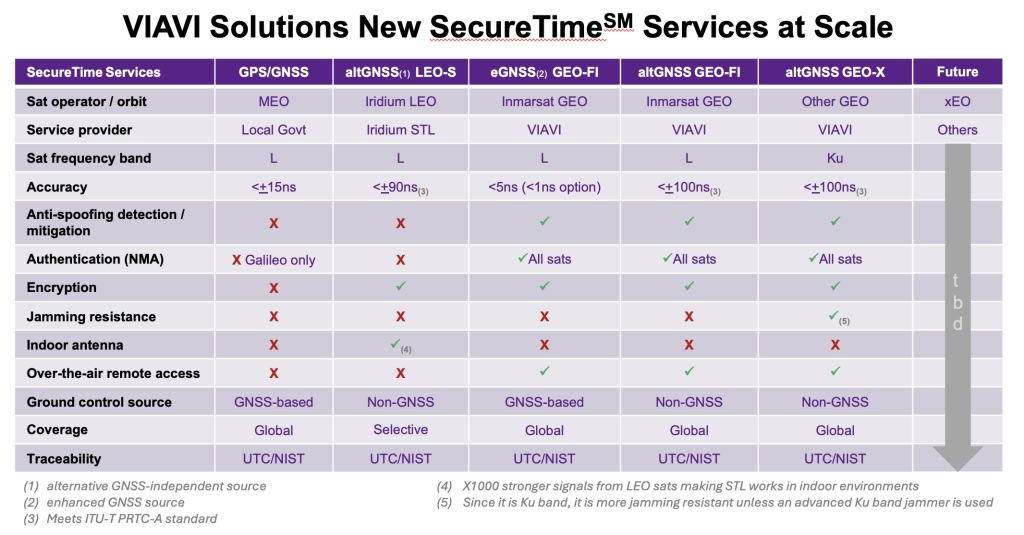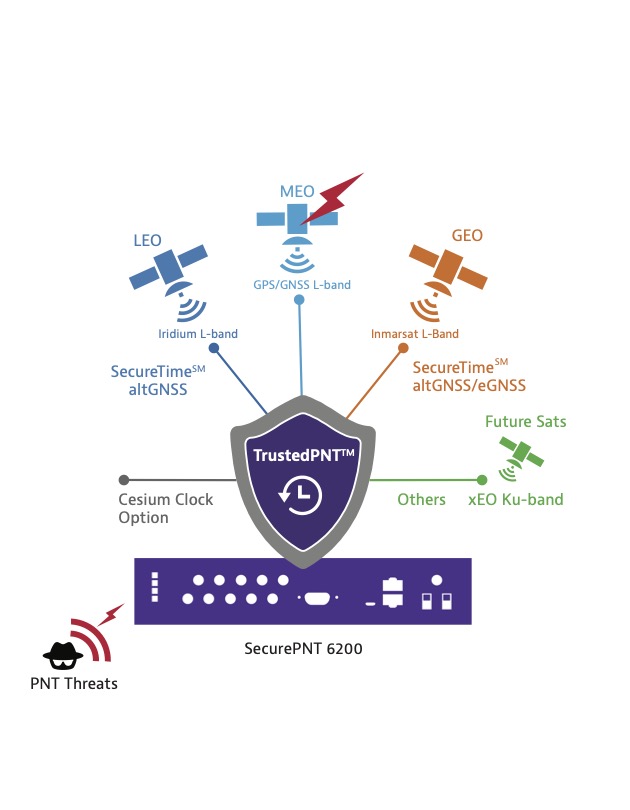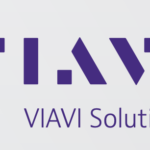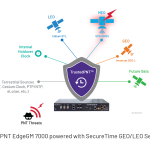For applications that require accurate UTC timing, the options are pretty limited. Yes, GPS provides timing, but it has its vulnerabilities. Iridium STL is the only other option with global coverage, but it has its drawbacks, too, as it’s restricted to L1 and can’t be leveraged for every application.
There’s certainly a gap in the market, and VIAVI is helping to fill it with the introduction of its new altGNSS GEO SecureTime service. The solution, available worldwide, aims to deliver improved nanoseconds-accurate UTC timing via L-Band and Ku-Band satellite signals—becoming only the third global independent capability that generates PNT signals locally.
The service is independent of traditional GPS and GNSS, serving as a reliable backup. And because it operates on the Ku-Band, it is very difficult to jam or spoof, unlike GPS. Its Navigation Message Authentication (NMA) uses encryption to detect spoofing in any signals, both cooperative and non-cooperative, received from any source.
The new service is already proven, having undergone testing in live-sky battlefield scenarios, showing it can provide assured PNT in a simulated warzone where GPS and GNSS are completely denied.
altGNSS GEO SecureTime is available today, with no scaling or satellite launches required, and can be leveraged for improved timing in many applications including 5G networks, transportation, data centers, smart grid, high-frequency trading, military and first responder communications, and satellite terminals. The service combines signals from government and commercial constellations across Geosynchronous Orbit (GEO), Low Earth Orbit (LEO) and Medium Earth Orbit (MEO).
VIAVI will produce receivers for third-party solution providers and integrate the services into its own products as well. VIAVI’s SecurePNT 6200 hardware platform, for example, is powered by space and terrestrial SecureTime Services and TrustedPNT multisource fusion technology.
Inside GNSS recently sat down with the industry leaders behind this significant development: Said Jackson, general manager and vice president; Giovanni D’Andrea, senior director of business development; Nino De Falcis, senior director, global PNT business development; and Andrew Popp, senior director of product line management. They provide insight into what role this technology will play and why it’s such a critical advancement for their customers and the industry.
Q: What gap in the market does this product fill? How is VIAVI uniquely positioned to bring this type of solution to bear?
D’Andrea: Jackson Labs, recently acquired by VIAVI, was all about timing in its previous life. We attacked the timing issue. Why? Your choices are pretty limited today if you want to achieve really good timing. GPS gives you timing, it’s not the best timing. There are also cesium clocks, but they’re not affordable. You have to buy one, use it to transport time, and then you lose time. And it always needs GPS to correct itself. So, does that solve the problem? Not really, because the more we evolve our technology from 3G to 5G and moving into 6G, timing is going to become more and more relevant.
GPS is alive 100% of the time, but it does go down. The next evolution is, how do we prepare for the people who are going to try to take it down? How do we prepare for threats?
Timing was one of the most important parts of the PNT solutions Jackson Labs started with. In this latest version of our product and our software, we’ve implemented authentication. That’s very big in this space. If somebody wants to take you down, they just send you a big spoofing signal and you think, hey, look My L1 is working, my L5 is working. But no, they’re not. We’re building from timing to now authenticating. If a signal isn’t valid anymore, and we compare it to what we’re doing, we eliminate it and move on to the next one. And we do this with every constellation out there.
Jackson: Today, you have traditional GNSS and only two of them are really usable for encrypted and authenticated applications. You have OSNMA and PRS with Galileo and you’ve got M-code and P-code for GPS. What other solutions are out there right now? Really the only one deployed globally is Satelles. There are a few others, but they aren’t widely deployed and don’t have the user equipment to receive them. So, really, you just have GNSS and STL. That’s the big impact we’re making. We’re creating a third leg here, altGNSS GEO SecureTime, which is a third independent solution that uses both L-Band and Ku-Band for that capability. You now have a third choice, and one that’s very easy to implement.
Our service is going to be very, very low cost and potentially rolled into hardware, which means you don’t have to maintain monthly licensing or fee tracking. You buy a piece of equipment from us, you plug it in and it just works. It can be bought as a physical product as well as a module to integrate into a system. It’s also signal agnostic, an important feature.
Q: How does the service resist spoofing and jamming attacks?
Jackson: The service uses two different bands, the L-Band and Ku-Band, and offers new capabilities. But the service doesn’t replace the other systems; it augments them and gives you one additional leg to stand on. What does that mean exactly? L-Band is fairly easily jammed and spoofed. We see that in the Middle East right now. We see that in Poland and Finland and other places. Ku-Band is more difficult to jam or spoof. To put together a 1 kilowatt or 10 kilowatt Ku-Band jammer is tough and expensive.
Accessing the Ku-Band is also cost effective. We’re leveraging geostationary satellites, which are harder to spoof or jam, by using very inexpensive commercial grade dishes that everybody is familiar with in the U.S.
D’Andrea: We tested many, many different solutions out there. And we looked at it and said, if you’re using a geostationary satellite and a parabolic antenna, the gains of that antenna could then potentially keep spoofing and jamming out of the equation. And we proved this in a real-life environment, where we were able to sustain every threat they threw at us during testing, including jamming and any kind of spoofing. We sustained every attack.
Q: What makes NMA different?
Jackson: The navigation message authentication supports all GNSS systems. The signals we send out are encrypted. We use over 90 ground stations in the world to measure the actual truth and send out encrypted authentication messages on a different channel that allow us to authenticate all of the GNSS signals on all the different GNSS frequences.
Basically, we’re using the Ku-Band to receive authentication messages over the air to detect spoofing in the L-band, with both cooperative signals and noncooperative signals, meaning signals of opportunity. The advantage of cooperative signals is you are completely standalone. You have one or two antennas and don’t need any other network connection or backhaul like an RTK link. For the noncooperative signals we’re working on right now, you do need a backhaul, and typically some sort of satellite terminal internet connection that will give you that information.
This means we just receive what’s there. And the advantage is, the Ku-Band is massive. If you jam a certain frequency in Ku-Band, you can easily switch over to a different transponder. There’s many, many transponders and many satellites you can receive. That’s one reason it’s so much more difficult to spoof and jam. With L-Band, that’s not the case. You can’t switch over your carrier.
Q: How does the service improve timing?
D’Andrea: Our system today is around the nanosecond, it’s 1 to 5 nanoseconds all the time. You’re actually synchronizing your rubidium clock to start off at a better position, so your holdover position is now extended by days or weeks.
Jackson: We can create sub-one nanosecond standard deviation timing accuracy. That far outperforms what you can get from GPS today. That allows you to generate a hydrogen maser-like stability locally anywhere in the world.
We’ve measured our Allan deviation performance and we exceed 1E-13, after 7,000 seconds of averaging. We’re in the xE-14 already, after about two hours of averaging. So, that’s at a minimum, high end, optical cesium-type performance. We can achieve that in the PNT box today, and that is an augmentation signal we send out.
Why is that important? Not everyone needs that level of accuracy. Well, if your error is plus or minus one or two nanoseconds, and you’re going to holdover, your holdover performance is going to be much, much better than if you’re jumping around plus or minus five or 10 nanoseconds. When you’re trying to follow GPS, you have these five nanosecond deviations in a typical day. That means you have to detune your oscillator to follow those deviations. And while you’re detuning your oscillator, if you go into holdover at that exact moment, your holdover performance is going to be limited. When you’re not required to detune the oscillator as much because your reference signal is so much better, five to 10x better than GPS by itself, you also will have much better average holdover performance because you’re driving much more in your lane, rather than drifting between two lanes.
D’Andrea: Timing is very important. The whole community needs timing. We need to know if something is happening and if it is, we have an L-Band and the Ku-Band advantage that in any kind of environment, these antennas, and the satellites that have been up for years, will keep your system going for as long as you want throughout any threats possible. And if we do lose any of those, we always fall back to a holdover capability through a rubidium clock.
Q: What is the benefit of using GEO satellites?
Jackson: The real innovation is the geostationary capability of the satellite. It sits on one spot in the sky. MEO and LEO can’t offer that. We can have signal gain through physics. If we can have 20 db gain, that’s 100 times more power. That means, if you want to jam it as effectively, you need drastically more power if you use a parabolic. A lot of applications don’t want to have a parabolic because they’re challenging to install and calibrate, so we offer both parabolic and non-parabolic Ku-Band reception, which is unique. We send out signals on L-Band as well, so if you don’t want to go to Ku-Band you don’t have to. You can use either or both. They’re not dependent on each other but they augment each other.
Q: How does the service back up GPS?
Jackson: We can generate UTC timing entirely from the Ku-Band, so we do not need to receive anything else or have a backhaul network connection. We don’t need to receive GNSS. We don’t need to receive anything in L-Band. We can generate accurate UTC timing or accurate enough UTC timing, sub one microsecond accuracy, easily by just tracking the Ku-Band. It’s completely independent of GNSS.
Q: How will customers use the new service?
De Falcis: First of all, we need to understand the network today. Everybody uses GPS, and then transforms GPS into the PTP, NTP protocol into the network and then transfers that to different nodes, synchronizing the network. But all those protocols are only as good as GPS. If GPS goes down, everything goes down. On some nodes they’re combining GPS with cesium clocks and calling it bullet proof PTP, because it’s fed by cesium while GPS is down. But it will only hold 100 nanoseconds for 50 days, 100 days, and that’s it. It’s still a holdover. It will not keep your network forever if you have a major outage.
Second, you need to look at the customer’s risk profile and budget. The biggest risk profile is defense. Obviously, they want all the sources that are available. They cannot go down, because if they go down, they lose the war. M-Code goes down. STL goes down. So, we came up with L-Band GEO and Ku-Band GEO to fill the need.
Look at it like a barstool with three legs. We started with one leg, which is GPS, trying not to fall, and then we added another leg, STL. That gave us two legs, but it’s still not that stable. STL reduces some of the weaknesses of GPS, but not all of them. So, we added another leg with this service, and we may add another in a year or two. But the third leg on this PNT barstool makes it more stable, more diversified, and diminishes the risk.
If you go indoors, STL is the solution; GEO won’t give you indoor capability. For those customers, they get GPS and STL. But STL has some weaknesses, so we are now providing another service with anti-spoofing, but it doesn’t have that indoor capability. The point is, there is not one source that fits all. If you want the life insurance, then you have to get them all.

Q: What does this new offering and recent Jackson Labs acquisition mean for VIAVI?
Popp: Adding a services capability really broadens what we can offer to our customers, and it really makes us a better partner. If we look at VIAVI as a larger entity, this expands the VIAVI capability and gets us into additional market spaces. The Jackson Labs acquisition provides additional support for the expansion. It’s very complementary for the product space and also fits well with the VIAVI business model.
We’re able to take what Jackson Labs did and scale with additional engineering resources and talent as well as a sales and distribution network to really proliferate the products and services not only in North America, but worldwide.
VIAVI will be at the JNC meeting this week to talk about this new service and other solutions. You can find them at booth 310.
Learn more at https://www.viavisolutions.com/en-us/products/securepnt-6200-securetime-altgnss-egnss-services.






